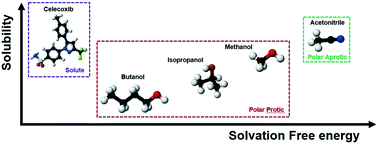Thermodynamic solubility of celecoxib in organic solvents†
Abstract
The present work investigates the solubility of the stable polymorph of celecoxib (CEL) drug in a range of pure organic solvents, including methanol, isopropanol, butanol, ethyl acetate, acetonitrile and toluene, within the temperature range 278–303 K. The solid form used has been characterized by SEM, PXRD, DSC, TGA, FTIR and Raman spectroscopy. The solid form studied exhibited a melting temperature of 437.45 K, with an associated melting enthalpy of 35.93 kJ mol−1. The experimental solubility data obtained was fitted to empirical and semi-empirical models, so that the parameters obtained enable the interpolation of further solubility data within the range explored. In the studied solvents, the solubility decreases in the order: ethyl acetate > acetonitrile > methanol > isopropanol > butanol > toluene. In all the solvents used, except for in toluene, the experimental solubility values are higher than the ideal ones, indicating negative deviation with respect to Raoult's law and favourable solute–solvent interactions. The solubility order of CEL in alcohols correlated well with the solvent polarity and this finding is complemented with the CEL–solvent interactions determined by molecular dynamics simulations. The high solubility of CEL in ethyl acetate is attributed to the similar Hildebrand solubility parameter of both species.



 Please wait while we load your content...
Please wait while we load your content...